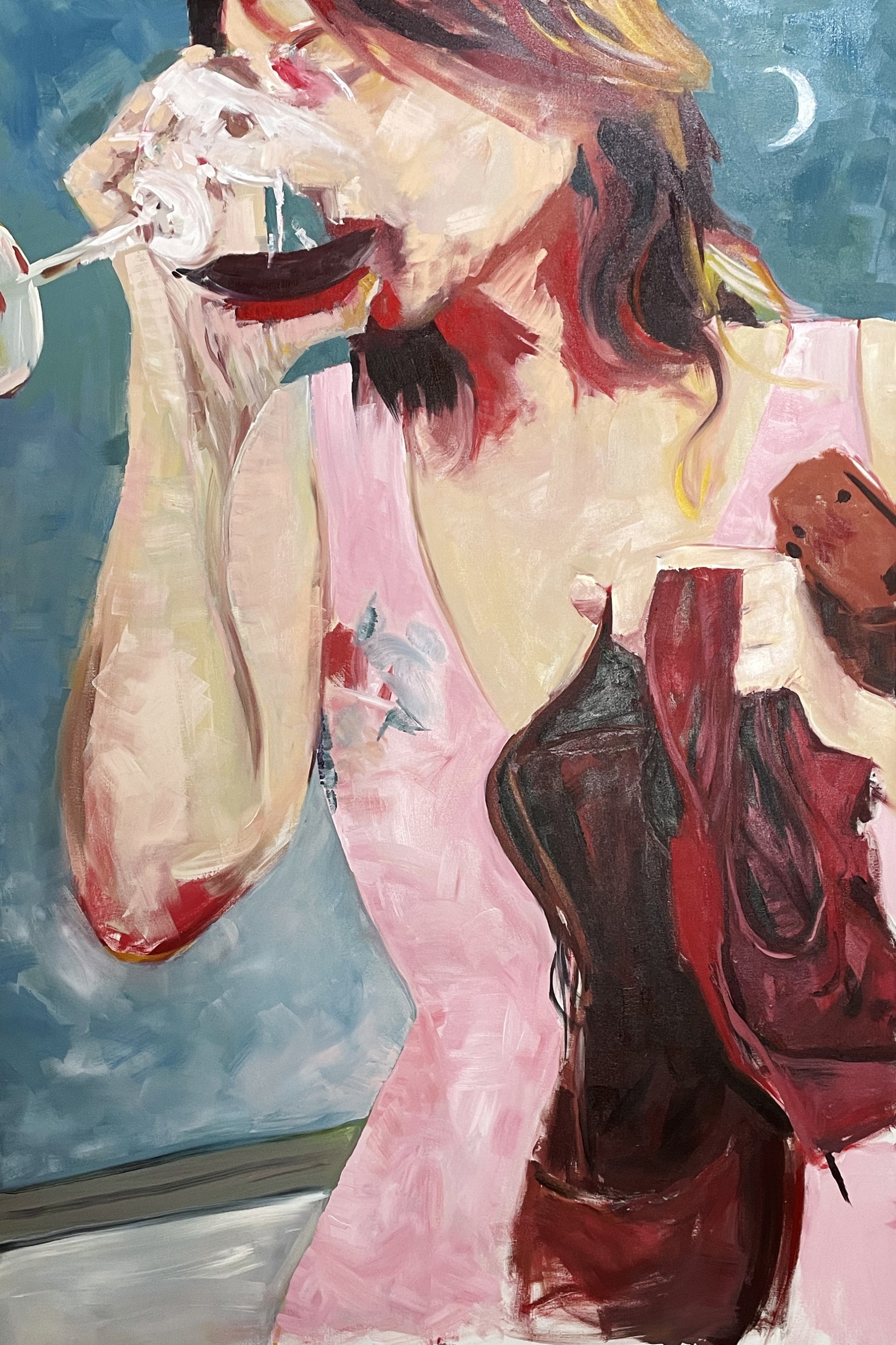Details
| First Name | Marina |
| Last Name | Quintanilha Ribeiro |
| Username | marinar |
| Bio | b., lives and works in São Paulo, Brazil Marina Quintanilha is a visual artist born in São Paulo. He develops his work in transit between the languages of painting, experimental animation and cinema, creating narratives from the image that are situated between reality and fiction. Using her body and her life experiences as a starting point, the artist plays with the transposition of languages and the complexity of the idea of authorship. The vocabularies of contemporary art and audiovisual — at first autonomous — mix and create fragments of stories whose meaning remains open. The interpretations and sensations provoked by the works are always provisional, as numerous as the stories and desires of those who see them — also becoming authors, or accomplices. Photoperformances are transformed into markedly gestural oil paintings, which have a typical cinema framing. Although they look like self-portraits, the artist-character does not show her face. The animations keep the quick stroke of the pencil on the paper and the image of its rough texture, but are presented on a computer or TV screen. Documentary cinema, in turn, deals with real stories of subjects who can be betrayed by memory, itself fragmented, inventive and creative. Quintanilha was awarded at the É Tudo Verdade Festival with her short film Borscht, a Russian recipe (2014), participated in the exhibition 35 Anos de Laura at Casa de Cultura Laura Alvim (2022), promoted by Uncool Artist. She was selected for the Garimpo award for new talents in 2023 by DasArtes magazine and had her work included in the IlustraDelas public notice for exhibition at Pátio metro São Bento (2023). Recently, he participated in SP Arte, represented by Galeria Izabel Pinheiro. -=≡=- n., vive e trabalha em São Paulo, Brasil Marina Quintanilha é artista visual nascida em São Paulo. Desenvolve seu trabalho no trânsito entre as linguagens da pintura, da animação experimental e do cinema, criando narrativas a partir da imagem que se situam entre realidade e ficção. Utilizando seu corpo e suas experiências de vida como ponto de partida, a artista joga com a transposição de linguagens e a complexidade da ideia de autoria. Os vocabulários da arte contemporânea e do audiovisual — a princípio autônomos — se misturam e criam fragmentos de histórias cujo sentido permanece em aberto. As interpretações e sensações provocadas pelos trabalhos são sempre provisórias, tão numerosas quanto as histórias e os desejos daqueles que os veem — tornando-se também autores, ou cúmplices. Fotoperformances são transformadas em pinturas a óleo marcadamente gestuais, que têm o enquadramento típico do cinema. Embora pareçam autorretratos, a artista-personagem não mostra seu rosto. As animações guardam o traço rápido do lápis no papel e a imagem de sua textura rugosa, mas são apresentadas numa tela de computador ou de TV. O cinema documental, por sua vez, trata de histórias reais de sujeitos que podem ser traídos pela memória, ela própria fragmentada, inventiva e criadora. Quintanilha foi premiada no Festival É Tudo Verdade com seu curta Borscht, uma receita russa (2014), participou da exposição 35 Anos de Laura na Casa de Cultura Laura Alvim (2022), promovida pela Uncool Artist. Foi selecionada para o prêmio Garimpo de novos talentos de 2023 pela revista DasArtes e teve sua obra contemplada no edital IlustraDelas para exposição no Pátio metrô São Bento (2023). Recentemente, participou da SP Arte, representada pela Galeria Izabel Pinheiro.
|
| Website | |
| Country of residence | Brazil |
Statement
| Statement | When I was 20 years old, I read a headline in a science magazine: Scientists discover that time is a substance. That’s when I had my first anxiety attack. I’ve never read this article, but since then time has been a potent issue in my works. Perhaps because I am also an animator and spend a large part of my day looking at a timeline, it makes the past, the present and the future latent issues in my life. I spend most of it sculpting time, as Tarkovski says in his book on the art of filmmaking. When I turned 30, I made a Mnemosyne Atlas of my life. A panel of 30 photos, one for each year lived. Looking at this panel, I had the dimension of the amount of time I had lived until then. The past was very close, and the end was not so far either. A third of my probable existence had already passed (If all goes well). After that realization, I wanted to make graphs of cycles, feelings, traumas and analyze my life as we analyze Joseph Campbell’s hero’s journey in a movie script. I just didn’t do it because I found it kind of pathological and narcissistic. I just told my analyst to see if Lacan could help me with that. But I can’t escape this feeling that my life is a narrative I tell myself. And that is reflected in my productions. I think through images. I went to understand my mother when I made a short film about my Russian family. Looking at her through the cameras, I could understand things that no analysis could do for me. I can only understand my life when I see it from the outside, as a spectator. That’s why I’m so autobiographical. Contrary to what it may seem, I’m looking at myself from the outside, and not showing myself to the other. My painting reflects this movement. It’s me looking at myself. The body I inhabit and the objects I relate to. When I’m alone, the feeling of existing is complete. And freedom is total. Photography captures that moment and paralyzes time. Then, to carry out the painting process, I have to dismember the image into colors and shapes to the ultimate consequences, taking the reflection beyond the symbolic content, now, in the time of painting. The photographic image is dematerialized as in a time machine. It is transported and decoded to a screen, bringing, in addition to that figurative moment, details and expressive traits that also carry formal meanings. In addition to the interior time of the portrayed figure and the time travel of the dematerialization of photography into painting, it is also possible to see historical time in my work. Nowadays, women have found their voice on social media and the feminine theme is in vogue. We’re talking about women like never before. Therefore, the woman as subject, the self, the exposed intimacy of my paintings, can also be considered a theme of our present time in my work. -=≡=- Aos 20 anos de idade eu li numa revista científica uma manchete: Cientistas descobrem que tempo é uma substância. Foi quando tive minha primeira crise de ansiedade. Nunca li essa matéria, mas desde lá o tempo é uma questão potente nos meus trabalhos. Talvez por ser também animadora e passar grande parte do meu dia olhando para uma timeline, faz com que o passado, o presente e o futuro sejam questões latentes na minha vida. Passo a maior parte dela, esculpindo o tempo, como diz Tarkovski no seu livro sobre a arte de fazer cinema. Quando completei 30 anos, fiz um Atlas Mnemosyne da minha vida. Um painel de 30 fotos, uma para cada ano vivido. Observando esse painel, tive a dimensão da quantidade de tempo que havia vivido até então. O passado estava muito perto, e o fim também não tinha tanta distância. Um terço da minha provável existência já havia se passado. (Isso se tudo desse certo). Depois dessa constatação, tive vontade de fazer gráficos de ciclos, sentimentos, traumas e analisar minha vida assim como analisamos a jornada do herói de Joseph Campbell em um roteiro de filme. Só não o fiz porque achei meio patológico e narcisista, e acabei só levando essa impressão verbalmente para o meu analista, para ver se Lacan me ajudava com isso. Mas não escapo dessa sensação de que minha vida é uma narrativa que conto para mim mesma. E isso se reflete nas minhas produções. Penso através de imagens. Fui entender minha mãe quando fiz um curta sobre minha família russa. Olhando-a através das câmeras, pude entender coisas que nenhuma análise conseguiu fazer por mim. Só consigo compreender minha vida, quando a vejo de fora, como uma espectadora. Por isso sou tão autobiográfica. Ao contrário do que possa parecer, estou me olhando de fora, e não me mostrando para o outro. A minha pintura reflete esse movimento. Sou eu olhando para mim mesma. O corpo que eu habito e os objetos com os quais me relaciono. Quando estou sozinha o sentimento de existir é completo. E a liberdade é plena. A fotografia capta esse instante e paralisa o tempo. Em seguida, para realizar o processo da pintura, tenho que desmembrar a imagem em cores e formas às últimas consequências, levando a reflexão para além do conteúdo simbólico, agora, no tempo da pintura. A imagem fotográfica se desmaterializa como numa máquina do tempo, e se transporta decodificada para uma tela, trazendo, além daquele instante figurativo, detalhes e traços expressivos que também carregam significados formais. Além do tempo interior da figura retratada e da viagem no tempo da própria desmaterialização da fotografia em pintura, também é possível ver no meu trabalho o tempo histórico. Hoje em dia a mulher encontrou a sua voz nas redes sociais e o tema feminino está em voga. Estamos falando sobre as mulheres como nunca antes foi falado. Por isso, a mulher como sujeito, a self, a intimidade exposta das minhas pinturas, também pode ser considerado um tema do nosso tempo presente na minha obra.
|
Exhibitions
| Exhibitions | Quintanilha was awarded at the É Tudo Verdade Festival with her short film Borscht, a Russian recipe (2014), participated in the exhibition 35 Anos de Laura at Casa de Cultura Laura Alvim (2022), promoted by Uncool Artist. She was selected for the Garimpo award for new talents in 2023 by DasArtes magazine and had her work included in the IlustraDelas public notice for exhibition at Pátio metro São Bento (2023). Recently, he participated in SP Arte, represented by Galeria Izabel Pinheiro. |
Interests and medias
| Interests | Painting |
| Painting medias | Oil |


Social Media